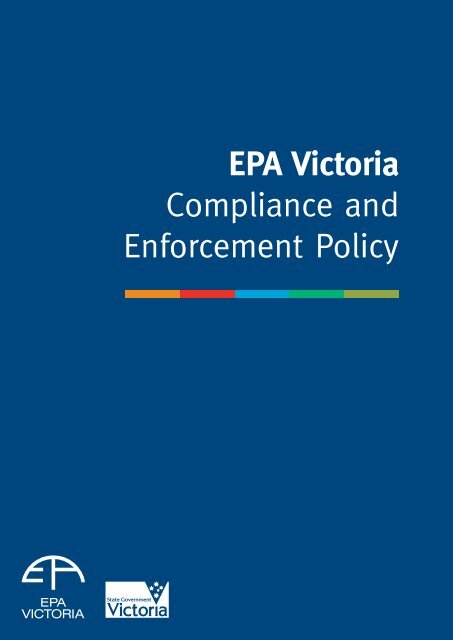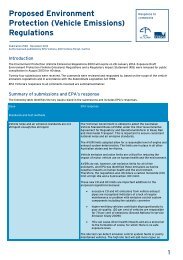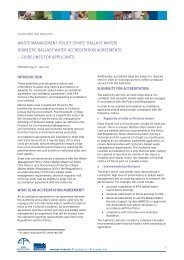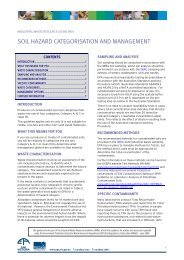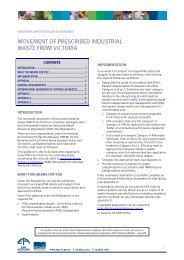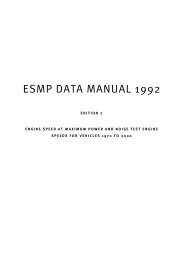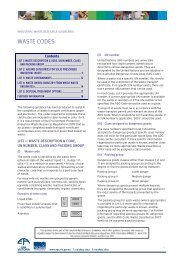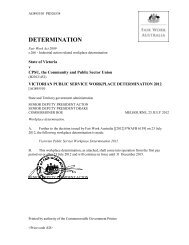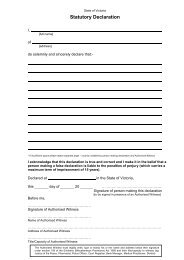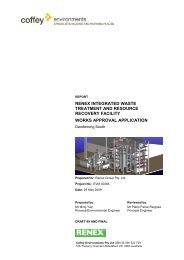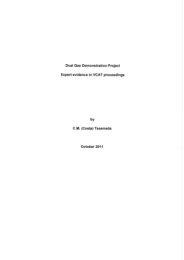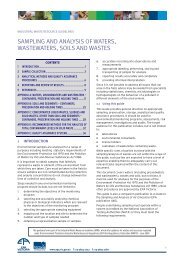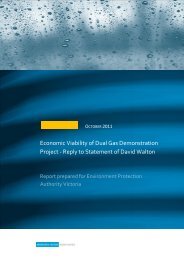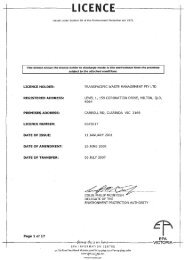EPA Victoria Compliance and Enforcement Policy
EPA Victoria Compliance and Enforcement Policy
EPA Victoria Compliance and Enforcement Policy
You also want an ePaper? Increase the reach of your titles
YUMPU automatically turns print PDFs into web optimized ePapers that Google loves.
<strong>EPA</strong> <strong>Victoria</strong><br />
<strong>Compliance</strong> <strong>and</strong><br />
<strong>Enforcement</strong> <strong>Policy</strong>
Publication 1388<br />
June 2011<br />
<strong>EPA</strong> <strong>Victoria</strong><br />
200 <strong>Victoria</strong> Street<br />
Carlton 3053, <strong>Victoria</strong>, Australia
Contents<br />
1. Purpose of compliance <strong>and</strong> enforcement 4<br />
2. Principles of compliance <strong>and</strong> enforcement 5<br />
3. Environment protection — <strong>EPA</strong> <strong>Victoria</strong>’s regulatory model 6<br />
4. <strong>EPA</strong>’s regulatory approach 8<br />
5. Monitoring, detecting <strong>and</strong> investigating non-compliance 14<br />
6. <strong>Compliance</strong> <strong>and</strong> enforcement measures 19<br />
7. Sanctioning 21<br />
8. Publication of enforcement information 34<br />
9. Decision-making framework for enforcement action 35<br />
10. <strong>EPA</strong>’s enforcement response 36<br />
11. <strong>EPA</strong>’s approach to targeted enforcement 38<br />
<strong>Compliance</strong> <strong>and</strong> enforcement tools – quick reference guide<br />
Remedy<br />
<strong>Compliance</strong> advice 19<br />
Statutory notices <strong>and</strong> directions 19<br />
Oral or written directions by an Authorised Officer 20<br />
Sanctions<br />
Warnings 22<br />
Infringement notices 23<br />
Notices of contravention 26<br />
Enforceable undertakings 27<br />
Suspension of licence or permit 28<br />
Injunctions 29<br />
Prosecutions 30<br />
Court orders <strong>and</strong> alternative sentencing 32<br />
Revocation of licence or permit 33<br />
Authorised <strong>and</strong> published by <strong>EPA</strong> <strong>Victoria</strong>, 200 <strong>Victoria</strong> Street, Carlton
4<br />
1. Purpose of compliance<br />
<strong>and</strong> enforcement<br />
Environment Protection Authority (<strong>EPA</strong>) <strong>Victoria</strong> protects <strong>and</strong><br />
improves our environment by preventing harm to the environment<br />
<strong>and</strong> human health. <strong>EPA</strong>’s vision is a healthy environment<br />
that supports a liveable <strong>and</strong> prosperous <strong>Victoria</strong>. We want<br />
environmental outcomes that allow all <strong>Victoria</strong>ns to have clean<br />
air, healthy waterways, safe l<strong>and</strong> <strong>and</strong> minimal disturbances from<br />
noise <strong>and</strong> odour.<br />
As an effective environmental regulator <strong>EPA</strong>’s role is to monitor industry <strong>and</strong> ensure it complies with the<br />
Environment Protection Act 1970 (EP Act) 1 to achieve the environmental outcomes we want for <strong>Victoria</strong>. The EP<br />
Act is a framework to protect <strong>Victoria</strong>’s environment <strong>and</strong> it also sets out a set of overarching principles that<br />
<strong>EPA</strong> must consider. 2 <strong>EPA</strong>, <strong>and</strong> its Authorised Officers, are also responsible for ensuring compliance with the<br />
Pollution of Waters by Oils <strong>and</strong> Noxious Substances Act 1986 (POWBONS Act). 3<br />
<strong>EPA</strong> aims to be an effective regulator <strong>and</strong> an influential authority on environmental impacts that also exercises<br />
its statutory authority fairly <strong>and</strong> credibly. This policy articulates <strong>EPA</strong>’s approach, method <strong>and</strong> priorities in<br />
ensuring compliance with our Acts <strong>and</strong> carrying out our compliance <strong>and</strong> enforcement powers. The policy also<br />
identifies many of <strong>EPA</strong>’s enforcement powers, how they differ depending on how severe the non-compliance<br />
is, <strong>and</strong> an explanation of how <strong>and</strong> when they will be used. <strong>EPA</strong> commits itself to this policy <strong>and</strong> the principles it<br />
establishes.<br />
<strong>EPA</strong> will balance the use of our influence <strong>and</strong> enforcement tools to achieve compliance, uphold environmental<br />
st<strong>and</strong>ards <strong>and</strong> drive environmental improvement. Our role in driving environmental improvement is<br />
clearly described in section 1L of the EP Act, which states that ‘the aspirations of the people of <strong>Victoria</strong> for<br />
environmental quality should drive environmental improvement.’<br />
The policy is divided into four key parts:<br />
• <strong>EPA</strong>’s regulatory model, approach <strong>and</strong> principles (sections 2 – 4)<br />
• monitoring compliance (section 5)<br />
• compliance <strong>and</strong> enforcement measures (sections 6, 7, 9 – 11)<br />
• publication of enforcement information (section 8).<br />
1 Including environment protection regulations (regulations) <strong>and</strong> state environment protection <strong>and</strong> industrial waste management<br />
policies (policies).<br />
2 See EP Act, sections 1B to 1L.<br />
3 The Act is used to prevent pollution of <strong>Victoria</strong>’s marine environment through setting requirements for boat <strong>and</strong> ship<br />
owners <strong>and</strong> masters.
2. Principles of compliance<br />
<strong>and</strong> enforcement<br />
This policy explains how <strong>EPA</strong> uses enforcement to achieve<br />
compliance <strong>and</strong> create credible deterrents against breaking<br />
the law.<br />
<strong>EPA</strong> is guided by eight principles when undertaking its compliance <strong>and</strong> enforcement role, exercising its<br />
regulatory responsibility <strong>and</strong> administering the EP Act. The principles are:<br />
Targeted: We will target our compliance <strong>and</strong> enforcement activities to prevent the most serious risk<br />
or harm.<br />
Proportionate: Regulatory measures <strong>and</strong> responses will be proportional to the problem they seek to<br />
address <strong>and</strong> how culpable, or responsible for the problem, the offender is.<br />
Transparent: Regulations <strong>and</strong> st<strong>and</strong>ards will be developed <strong>and</strong> enforced transparently. Information <strong>and</strong><br />
any lessons learned will be shared <strong>and</strong> promoted. <strong>Enforcement</strong> actions will be public, to<br />
build the credibility of, <strong>and</strong> confidence in, <strong>EPA</strong>’s regulatory approach <strong>and</strong> processes.<br />
Consistent: Outcomes from our enforcement activities should be consistent <strong>and</strong> predictable. <strong>EPA</strong><br />
aims to ensure that similar circumstances, non-compliances <strong>and</strong> incidents lead to similar<br />
enforcement outcomes.<br />
Accountable: To ensure full accountability, the compliance of duty-holders 4 , our enforcement decisions<br />
<strong>and</strong> the conduct of Authorised Officers will be explained <strong>and</strong> open to public scrutiny.<br />
Inclusive: <strong>EPA</strong> will engage with the community, business <strong>and</strong> government to promote environmental<br />
laws, set st<strong>and</strong>ards <strong>and</strong> provide opportunities to participate in compliance <strong>and</strong><br />
enforcement.<br />
Authoritative: <strong>EPA</strong> is prepared to be judged on whether individuals <strong>and</strong> business underst<strong>and</strong> the law <strong>and</strong><br />
their obligations.<br />
<strong>EPA</strong> will set clear st<strong>and</strong>ards, clarify <strong>and</strong> interpret the law <strong>and</strong> provide authoritative<br />
guidance <strong>and</strong> support on what duty-holders need to do to comply.<br />
<strong>EPA</strong> will also be an authoritative source of information on the state of the environment,<br />
the level of compliance with the laws it regulates, <strong>and</strong> what the key risks <strong>and</strong> new <strong>and</strong><br />
emerging issues are.<br />
Effective: <strong>Enforcement</strong> activity will seek to prevent environmental harm <strong>and</strong> impacts to health, <strong>and</strong><br />
improve the environment. <strong>Enforcement</strong> action will be timely to minimise environmental<br />
impacts <strong>and</strong> maximise the effectiveness of any deterrence.<br />
4 <strong>EPA</strong> regards anyone who has a duty or obligation under the EP Act as a duty-holder<br />
<strong>Compliance</strong> <strong>and</strong> <strong>Enforcement</strong> <strong>Policy</strong> 5<br />
PurPoSE And PrinCiPlES
6<br />
3. Environment protection –<br />
<strong>EPA</strong> <strong>Victoria</strong>’s regulatory<br />
model<br />
<strong>EPA</strong>’s regulatory model is based on risk. <strong>EPA</strong> will prioritise<br />
compliance <strong>and</strong> enforcement activity, <strong>and</strong> allocate resources<br />
where it can, to make the biggest difference to <strong>Victoria</strong>’s<br />
environment by addressing the biggest risks to environment<br />
<strong>and</strong> health.<br />
The EP Act establishes <strong>EPA</strong> <strong>Victoria</strong> <strong>and</strong> provides a framework for preventing <strong>and</strong> controlling air, l<strong>and</strong> <strong>and</strong> water<br />
pollution <strong>and</strong> noise, increasing resource efficiency, reducing waste <strong>and</strong> improving environmental performance.<br />
<strong>EPA</strong> coordinates activities to do with the discharge of wastes into the environment; the generation, storage,<br />
treatment, transport <strong>and</strong> disposal of industrial waste; <strong>and</strong> the generation <strong>and</strong> release of noise.<br />
The EP Act gives us discretion in how we exercise our functions <strong>and</strong> address the harms <strong>and</strong> impacts it was<br />
established to prevent <strong>and</strong> control. This discretion includes how we prioritise <strong>and</strong> allocate our resources <strong>and</strong><br />
how enforcement decisions are made <strong>and</strong> what actions are taken. <strong>EPA</strong>’s regulatory model <strong>and</strong> this policy<br />
explain how we enforce the legislation we administer, <strong>and</strong> prioritise our compliance <strong>and</strong> enforcement activity.<br />
They outline the strategies we will apply when dealing with those industries <strong>and</strong> businesses we regulate.<br />
A risk-based <strong>and</strong> responsive regulatory model<br />
<strong>EPA</strong> will allocate our resources where the biggest difference can be made, or where the biggest risks to<br />
environment, health, safety or wellbeing can be managed.<br />
We have adopted a risk-based model in which our targeting of enforcement <strong>and</strong> our responses to incidents,<br />
compliance requirements, level of non-compliance <strong>and</strong> pollution reports will change depending on the risk or<br />
harm to health <strong>and</strong> the environment.<br />
<strong>EPA</strong> prioritises its compliance monitoring <strong>and</strong> inspection efforts towards the biggest risks of harm to the<br />
environment <strong>and</strong> to those people <strong>and</strong> businesses that are less likely to comply.<br />
<strong>EPA</strong> defines risk as a combination of two elements: consequence (the risk or harm to health <strong>and</strong> environment)<br />
<strong>and</strong> likelihood (the chance that non-compliance will occur).
LIKELIHOOD OF NON-COMPLIANCE<br />
Low Unlikely Possible Likely Certain<br />
<strong>EPA</strong>’s approach to targeted enforcement<br />
Low Minor Moderate Major Severe<br />
RISK OR HARM TO HEALTH AND ENVIRONMENT<br />
Consequence: The risk or harm to health or environment has five levels: low, minor, moderate, major<br />
<strong>and</strong> severe. This takes into account the actual or potential impacts on human health,<br />
environment <strong>and</strong> amenity. It also considers the scale <strong>and</strong> duration of any harm or impact<br />
<strong>and</strong> the level of public concern. See section 11 for a full description of the five risk levels.<br />
Likelihood: The likelihood of non-compliance also has five levels: low, unlikely, possible, likely <strong>and</strong><br />
certain. Likelihood takes into account (a) the track record of the business — past incidents,<br />
inspections, enforcement <strong>and</strong> pollution reports; (b) business systems in place to identify<br />
<strong>and</strong> manage environmental risk; (c) competence of the business <strong>and</strong> its operators; <strong>and</strong><br />
(d) the level of resources the business dedicates to environmental management,<br />
compliance <strong>and</strong> maintenance.<br />
When <strong>EPA</strong> starts the enforcement process following an incident of risk or non-compliance, we consider risk<br />
or harm <strong>and</strong> also take into account the circumstances <strong>and</strong> culpability of the offender. Culpability considers<br />
the offender’s history, how long the incident or non-compliance continued, whether or not the harm is still<br />
occurring or has been reduced, whether the risk was foreseeable <strong>and</strong> whether the act or omission was<br />
intentional. For a full description of culpability factors <strong>and</strong> <strong>EPA</strong>’s enforcement response, see section 10.<br />
Our regulatory model uses objective elements that can be applied when we target inspection activity <strong>and</strong><br />
other regulatory resources to those areas with the potential to cause the biggest harm. The model also allows<br />
a transparent discussion between a regulated business <strong>and</strong> <strong>EPA</strong> about the level of attention it might receive.<br />
<strong>Compliance</strong> <strong>and</strong> <strong>Enforcement</strong> <strong>Policy</strong> 7<br />
rEgulATory modEl
8<br />
4. <strong>EPA</strong>’s regulatory approach<br />
Encourage<br />
higher performance:<br />
Develop <strong>and</strong> work with<br />
leaders <strong>and</strong> partners<br />
to encourage higher<br />
performance <strong>and</strong><br />
leadership, which<br />
will build the case<br />
for improving practices<br />
<strong>and</strong> influencing<br />
future st<strong>and</strong>ards.<br />
Monitor<br />
compliance:<br />
Determine<br />
the level of<br />
compliance<br />
with current<br />
st<strong>and</strong>ards<br />
<strong>and</strong> laws, <strong>and</strong><br />
maintain a<br />
credible risk<br />
of detecting<br />
non-compliant<br />
activities.<br />
Encourage<br />
Higher<br />
Performance<br />
Inform <strong>and</strong> educate: Raise<br />
awareness of environmental laws<br />
<strong>and</strong> requirements; environmental<br />
quality; the environmental <strong>and</strong><br />
health impacts of activities <strong>and</strong><br />
people’s duty of care; <strong>and</strong> <strong>EPA</strong>’s<br />
role <strong>and</strong> jurisdiction.<br />
Monitor<br />
<strong>Compliance</strong><br />
Enforce the<br />
Law<br />
Inform <strong>and</strong><br />
Educate<br />
Enforce the law: Address non-compliance<br />
with the law <strong>and</strong> st<strong>and</strong>ards by objectively<br />
<strong>and</strong> assertively making the offender stop<br />
the non-compliant activity <strong>and</strong> fix any<br />
harm to the environment (the remedy) <strong>and</strong>,<br />
where appropriate, applying a penalty or<br />
punishment (the sanction).<br />
Set<br />
St<strong>and</strong>ards<br />
Support to<br />
Comply<br />
Set st<strong>and</strong>ards:<br />
Set environmental<br />
st<strong>and</strong>ards <strong>and</strong><br />
expectations for all<br />
activities – based<br />
on good science<br />
<strong>and</strong> consideration of<br />
community aspirations<br />
– through regulation,<br />
policy <strong>and</strong> approvals.<br />
Support to comply:<br />
Use advice, guidance<br />
<strong>and</strong> partnerships to<br />
ensure duty-holders<br />
underst<strong>and</strong> what<br />
compliance is <strong>and</strong><br />
how to identify <strong>and</strong><br />
manage the risks of<br />
their activities.
‘<strong>Compliance</strong>’ means following the law. it means obtaining the right<br />
approvals or permissions. it means conducting authorised activities<br />
in accordance with any conditions or regulatory requirements.<br />
<strong>Compliance</strong> is the responsibility of all businesses, organisations, governments <strong>and</strong> individuals. Everyone<br />
has obligations under the law. All parties have a social duty of care to the environment to reduce their<br />
environmental impact <strong>and</strong> ensure that future generations experience a clean <strong>and</strong> improved environment. All<br />
duty-holders are accountable to the regulator <strong>and</strong> the public to prevent <strong>and</strong> minimise environmental harm.<br />
<strong>EPA</strong> undertakes a range of activities on behalf of the <strong>Victoria</strong>n community to achieve compliance with the<br />
EP Act. <strong>EPA</strong> uses a balanced regulatory approach with a mix of compulsory <strong>and</strong> voluntary methods.<br />
Our approach to regulation involves a number of key steps:<br />
A. Inform <strong>and</strong> educate:<br />
Raising awareness of impacts, obligations, <strong>EPA</strong>’s role <strong>and</strong> a social duty of care<br />
A key role for <strong>EPA</strong> is to raise awareness<br />
of environmental laws <strong>and</strong> requirements;<br />
environmental quality; the environmental <strong>and</strong><br />
health impacts of activities <strong>and</strong> individual<br />
duty of care; <strong>and</strong> <strong>EPA</strong>’s role <strong>and</strong> jurisdiction.<br />
<strong>EPA</strong> will promote, on behalf of the community, its<br />
aspirations for an improved environment. We do this<br />
by stating what is the responsibility for environmental<br />
impacts from the activities of duty-holders — business,<br />
industry, local <strong>and</strong> state government bodies, <strong>and</strong><br />
individuals.<br />
We all share a social duty of care to protect the<br />
environment <strong>and</strong> to not cause harm.<br />
<strong>EPA</strong> will broadly promote its purpose, jurisdiction <strong>and</strong><br />
role in protecting the environment. We will clearly<br />
communicate our regulatory approach <strong>and</strong> how we work<br />
with co-regulators, community, business, government <strong>and</strong><br />
non-government organisations to protect, care for <strong>and</strong><br />
improve the environment.<br />
<strong>EPA</strong> emphasises education <strong>and</strong> raising awareness as an effective way of encouraging people to comply. Broad<br />
knowledge of what the environmental obligations are under the law will increase compliance <strong>and</strong> provide a<br />
common underst<strong>and</strong>ing for <strong>EPA</strong> to enforce the law.<br />
<strong>EPA</strong> will regularly communicate compliance levels <strong>and</strong> broadly promote our enforcement strategy, compliance<br />
plan <strong>and</strong> future compliance campaigns to provide clear information about areas or issues we are focusing on.<br />
<strong>Compliance</strong> <strong>and</strong> <strong>Enforcement</strong> <strong>Policy</strong> 9<br />
rEgulATory APProACh
10<br />
B. Set st<strong>and</strong>ards:<br />
Providing clear <strong>and</strong> authoritative st<strong>and</strong>ards based on science <strong>and</strong> community aspirations<br />
<strong>EPA</strong> sets environmental st<strong>and</strong>ards <strong>and</strong><br />
expectations for all activities through<br />
regulation, policy <strong>and</strong> approvals. These<br />
st<strong>and</strong>ards are based on good science <strong>and</strong><br />
consideration of community aspirations.<br />
<strong>EPA</strong> promotes compliance by setting clear st<strong>and</strong>ards <strong>and</strong><br />
raising awareness of risks <strong>and</strong> controls to protect the<br />
environment. <strong>EPA</strong> will be clear about what the law requires<br />
<strong>and</strong> will support duty-holders to achieve compliance by<br />
setting clear st<strong>and</strong>ards <strong>and</strong> providing guidance on how<br />
they can be met. St<strong>and</strong>ards focus on the key causes<br />
of environmental harm, seek to protect our sensitive<br />
environments <strong>and</strong> drive environmental improvement.<br />
St<strong>and</strong>ards are based on rigorous science, evidence,<br />
an underst<strong>and</strong>ing of the state of the environment <strong>and</strong><br />
current <strong>and</strong> future risks. St<strong>and</strong>ards will evolve over time<br />
with changing environmental conditions, national <strong>and</strong><br />
international st<strong>and</strong>ards <strong>and</strong> community aspirations.<br />
<strong>EPA</strong> will work with industry associations, businesses, community organisations, <strong>and</strong> local <strong>and</strong> state<br />
governments in developing st<strong>and</strong>ards <strong>and</strong> promoting good practice.<br />
In order to ensure laws <strong>and</strong> st<strong>and</strong>ards evolve <strong>and</strong> that st<strong>and</strong>ards of protection continuously rise to meet those<br />
st<strong>and</strong>ards, <strong>EPA</strong> supports duty-holders to perform beyond current st<strong>and</strong>ards.<br />
C. Support to comply:<br />
Providing practical, constructive <strong>and</strong> authoritative advice on how to comply with the law<br />
<strong>EPA</strong> promotes compliance by providing advice<br />
on how to comply with the law <strong>and</strong>, where<br />
non-compliance is found, how to remedy it.<br />
<strong>EPA</strong> uses advice, guidance <strong>and</strong> partnerships<br />
to ensure duty-holders underst<strong>and</strong> what<br />
compliance is <strong>and</strong> how to identify <strong>and</strong> manage<br />
the risks of their activities.<br />
One of <strong>EPA</strong>’s key functions is to provide advice to any<br />
person who has a duty or obligation under the EP Act,<br />
regulations or policy about how to comply with that duty<br />
or obligation.<br />
<strong>EPA</strong> <strong>and</strong> its Authorised Officers will provide practical<br />
<strong>and</strong> constructive advice on how to comply with the<br />
law, interpret st<strong>and</strong>ards <strong>and</strong>, where necessary, provide<br />
support on how to remedy any non-compliance.
This compliance advice may include referring people to applicable codes of practice, best practice<br />
management guidelines, protocols for environmental management, international st<strong>and</strong>ards or other relevant<br />
information. <strong>Compliance</strong> advice does not extend to providing legal advice.<br />
The onus for compliance will always rest with the party who has a duty or obligation under the law.<br />
Advice <strong>EPA</strong> provides will not give any additional legal rights or defences for any alleged non-compliance with<br />
the law. The degree to which a party takes into account advice provided by <strong>EPA</strong> will be taken into consideration<br />
when deciding whether to prosecute.<br />
D. Monitor compliance:<br />
Monitoring compliance with the law <strong>and</strong> maintaining a credible risk of detection<br />
A core function of <strong>EPA</strong> is to determine levels of<br />
compliance with current st<strong>and</strong>ards <strong>and</strong> laws,<br />
<strong>and</strong> maintain a credible risk of detecting noncompliance.<br />
<strong>EPA</strong>’s primary focus is on prevention; wherever possible,<br />
we want to ensure that incidents of non-compliance<br />
<strong>and</strong> their impacts are avoided. <strong>EPA</strong> constantly improves<br />
its capacity to detect <strong>and</strong> respond to non-compliance.<br />
When <strong>EPA</strong> identifies or becomes aware of a problem or a<br />
risk, it seeks to resolve the problem before it leads to an<br />
impact on the environment. Monitoring compliance <strong>and</strong><br />
investigating non-compliance is therefore a key role<br />
for <strong>EPA</strong>.<br />
Section 5 of this policy provides more details on<br />
monitoring methods, the purpose of investigations <strong>and</strong><br />
criteria for undertaking comprehensive investigations.<br />
<strong>Compliance</strong> <strong>and</strong> <strong>Enforcement</strong> <strong>Policy</strong> 11<br />
rEgulATory APProACh
12<br />
E. Enforce the law:<br />
Requiring parties to make good any (or ‘the’) harm caused, <strong>and</strong> deterring non-compliance<br />
<strong>EPA</strong> addresses non-compliance with the law<br />
<strong>and</strong> st<strong>and</strong>ards by objectively <strong>and</strong> assertively<br />
requiring remedy <strong>and</strong>, where appropriate,<br />
applying sanctions.<br />
‘<strong>Enforcement</strong>’ means the use of influence, authority <strong>and</strong><br />
statutory methods to compel compliance with the law.<br />
The EP Act includes a range of principles to guide <strong>EPA</strong>’s<br />
day-to-day activities <strong>and</strong> decisions. This policy supports<br />
the application of Principle 1K of the Act — the principle<br />
of enforcement (outlined below).<br />
Principle of enforcement<br />
<strong>Enforcement</strong> of environmental requirements should be<br />
undertaken for the purpose of:<br />
• better protecting the environment <strong>and</strong> its economic<br />
<strong>and</strong> social uses<br />
• ensuring that no commercial advantage is<br />
obtained by any person who fails to comply with<br />
environmental requirements<br />
• influencing the attitude <strong>and</strong> behaviour of persons whose actions may have adverse environmental impacts<br />
or who develop, invest in, purchase or use goods <strong>and</strong> services which may have adverse environmental<br />
impacts.<br />
<strong>Enforcement</strong> is just one way of achieving compliance. <strong>EPA</strong> can take enforcement action when legal<br />
requirements are contravened or not complied with. Requiring parties to meet their legal obligations or<br />
remedy their non-compliance is a key part of enforcing the law.<br />
<strong>Enforcement</strong> has two key elements:<br />
• Remedy: Fixing the problem or ‘making good’<br />
• Sanction: Applying a penalty or punishment for breaking the law<br />
<strong>EPA</strong> will use enforcement to address non-compliance, fix the problem <strong>and</strong> restore <strong>and</strong> ‘make good’ the harm<br />
caused by breaking the law. It may not always be possible to restore the environment to its previous state,<br />
so <strong>EPA</strong> will require offenders to ‘make good’ by minimising the extent of the damage or risks <strong>and</strong> taking all<br />
reasonable steps to remediate the impacts.<br />
Remedy <strong>and</strong> punishment can be used in combination, but all contraventions of the law will be met with a<br />
requirement to fix the problem <strong>and</strong> ‘make good’.
i. Remedy: Fix the problem or make good<br />
The first goal of enforcement is to stop non-compliance with the law <strong>and</strong> prevent further<br />
harm.<br />
Stopping non-compliance with the law or preventing or limiting harm may be done, for example, through an<br />
Authorised Officer issuing a pollution abatement notice or giving a direction.<br />
<strong>EPA</strong> will reflect the community’s expectation <strong>and</strong> the EP Act principle5 that the polluter should pay the cost<br />
of cleaning up pollution they have caused <strong>and</strong> restoring the environment.<br />
The cost of clean up <strong>and</strong> restoration won’t be taken into account if there is any further sanction or<br />
punishment given.<br />
ii. Sanction: Apply a penalty or punishment for breaking the law<br />
Sometimes remedying a breach is insufficient to deter lawbreakers.<br />
In some cases enforcement can include punishment, such as when people are prosecuted for serious<br />
breaches of the law. Punishing lawbreakers is an important <strong>and</strong> effective way of deterring people from<br />
breaching their environmental obligations.<br />
Sanctioning generally deters those offenders who might evade their obligations or seek to profit from<br />
breaking the law. In some circumstances it will be necessary to specifically deter them from offending<br />
in the future. It also levels the playing field financially for those who do the right thing <strong>and</strong> invest in<br />
prevention <strong>and</strong> environmental improvement.<br />
See sections 6 <strong>and</strong> 7 for more information on compliance, enforcement measures <strong>and</strong> sanctions.<br />
F. Encourage higher performance:<br />
Building the case for improving practices <strong>and</strong> influencing future st<strong>and</strong>ards<br />
<strong>EPA</strong> will develop <strong>and</strong> work with leaders <strong>and</strong><br />
partners to encourage higher performance <strong>and</strong><br />
leadership, building the case for improving<br />
practices <strong>and</strong> influencing future st<strong>and</strong>ards.<br />
<strong>EPA</strong> will work in partnership to promote higher<br />
performance <strong>and</strong> improvement that is aligned with <strong>EPA</strong>’s<br />
priorities, is focused <strong>and</strong> will develop future st<strong>and</strong>ards.<br />
We will drive performance, improvements <strong>and</strong> leadership<br />
that may apply to specific sites, sectors, geographic areas<br />
<strong>and</strong> business or industry groups.<br />
This may involve establishing <strong>and</strong> supporting networks,<br />
holding seminars, publicising case studies, organising<br />
field visits, <strong>and</strong> providing grants, in-kind support <strong>and</strong><br />
incentives for people who do the right thing <strong>and</strong> go<br />
beyond minimum st<strong>and</strong>ards.<br />
5 See EP Act section 1F(2) the Principle of improved valuation, pricing <strong>and</strong> incentive mechanisms — Persons who generate pollution <strong>and</strong><br />
waste should bear the cost of containment, avoidance <strong>and</strong> abatement.<br />
<strong>Compliance</strong> <strong>and</strong> <strong>Enforcement</strong> <strong>Policy</strong> 13<br />
rEgulATory APProACh
14<br />
5. monitoring, detecting<br />
<strong>and</strong> investigating<br />
non-compliance<br />
<strong>EPA</strong> monitors compliance <strong>and</strong> detects non-compliance using<br />
proactive <strong>and</strong> responsive methods <strong>and</strong> undertakes both<br />
regular <strong>and</strong> comprehensive investigations. <strong>EPA</strong> is strongly<br />
supported in detecting pollution through reporting by the public,<br />
local communities, business <strong>and</strong> other government <strong>and</strong><br />
non-government organisations.<br />
A. Monitoring <strong>and</strong> detecting non-compliance<br />
<strong>Compliance</strong> is monitored <strong>and</strong> breaches detected through a number of proactive <strong>and</strong><br />
responsive methods including:<br />
• site visits <strong>and</strong> inspections<br />
• covert surveillance<br />
• field <strong>and</strong> desktop audits<br />
• community, employee or duty-holder reports<br />
• monitoring data <strong>and</strong> sample collection<br />
• observations by <strong>EPA</strong> officers<br />
• observations <strong>and</strong> reports from other agencies or regulatory authorities<br />
• analysis of intelligence including information, data, financial records, aerial photography <strong>and</strong> reports.<br />
i. Site visits <strong>and</strong> inspections<br />
Proactive <strong>and</strong> planned site inspections are an important method by which <strong>EPA</strong> can<br />
determine compliance <strong>and</strong> prevent incidents <strong>and</strong> breaches.<br />
<strong>EPA</strong> will maximise planned <strong>and</strong> proactive inspections, <strong>and</strong> will target areas of greatest risk <strong>and</strong> where<br />
non-compliance is most likely. During an inspection, <strong>EPA</strong> staff will provide feedback to duty-holders of<br />
their observations <strong>and</strong> any proposed further actions.
ii. Community <strong>and</strong> public reports<br />
The community plays an important role in detecting <strong>and</strong> reporting pollution <strong>and</strong><br />
potential impacts on the environment.<br />
Information from the general public, industry, non-government organisations <strong>and</strong> other government<br />
agencies is a key source of intelligence for <strong>EPA</strong> inspections. <strong>EPA</strong> will constructively receive <strong>and</strong> use<br />
public reports, <strong>and</strong> ensure feedback is provided to reporters on any action taken, as well as the result<br />
of that action.<br />
<strong>EPA</strong>’s pollution report line is available 24 hours a day. <strong>EPA</strong> also encourages industry <strong>and</strong> business to<br />
establish their own public reporting lines, in order to better underst<strong>and</strong> <strong>and</strong> respond to impacts on<br />
neighbourhood amenity such as odour <strong>and</strong> noise.<br />
B. Investigating non-compliance<br />
We will assess all reported or detected contraventions of the law, regulations <strong>and</strong> other<br />
requirements to determine their priority for further compliance <strong>and</strong> enforcement action.<br />
We will prioritise to ensure the most effective use of our resources.<br />
Our initial assessment typically includes a preliminary examination <strong>and</strong> analysis of the report or allegation<br />
in order to decide its seriousness, the likelihood that a contravention has occurred <strong>and</strong> the probable<br />
consequences. Wherever possible, <strong>EPA</strong> will act to prevent a potential breach <strong>and</strong> discourage ongoing <strong>and</strong><br />
future breaches.<br />
Based on the outcome of the initial assessment <strong>and</strong> what we can do under the law, <strong>EPA</strong> will determine the<br />
appropriate level, if any, of further investigation or response.<br />
i. Aim of <strong>EPA</strong> investigations<br />
Any <strong>EPA</strong> investigation aims to:<br />
• determine whether a law, regulation, policy or other requirement has been contravened<br />
• determine what, if any, impact to the environment has occurred <strong>and</strong> provide advice or direction on<br />
stopping <strong>and</strong> preventing further impact <strong>and</strong> any future required actions<br />
• collect evidence that can be used in criminal prosecutions or that might assist with other<br />
appropriate compliance <strong>and</strong> enforcement measures<br />
• improve controls to prevent current <strong>and</strong> future non-compliance<br />
• deter further or similar action to that which led to the non-compliance<br />
• improve public confidence in the integrity of the regulatory system<br />
• achieve an appropriate outcome within a reasonable time <strong>and</strong> at reasonable cost<br />
• investigate all complicit parties involved in any incident or non-compliance.<br />
A range of <strong>EPA</strong> officers undertake investigations. The nature, time taken <strong>and</strong> method of investigation<br />
will be determined by the circumstances of the particular incident or contravention. The evidence<br />
gathered in these investigations can form part of a comprehensive investigation.<br />
moniToring, dETECTing And<br />
inVESTigATing non-ComPliAnCE<br />
<strong>Compliance</strong> <strong>and</strong> <strong>Enforcement</strong> <strong>Policy</strong> 15
16<br />
ii. Comprehensive investigations<br />
Comprehensive investigations are directed at the most serious environmental incidents<br />
<strong>and</strong> breaches that are likely to warrant a prosecution or other serious response.<br />
A comprehensive investigation is one that involves the collection of evidence that will form a ‘brief of<br />
evidence’. <strong>EPA</strong> will then review the brief of evidence to determine whether there is sufficient evidence<br />
that a criminal offence has been committed. The evidence must be credible <strong>and</strong> admissible in a court.<br />
In these circumstances, <strong>EPA</strong> may commence a criminal prosecution.<br />
Comprehensive investigations are undertaken in order to determine:<br />
• whether there is evidence that an offence has been committed under the EP Act or other laws<br />
administered by <strong>EPA</strong><br />
• the causes <strong>and</strong> consequences of non-compliance<br />
• the environmental harm caused by the non-compliance<br />
• whether, or the extent to which, the offender benefited commercially from the non-compliance<br />
• the identity <strong>and</strong> responsibility of each party complicit in the offence<br />
• whether action has been taken, or needs to be taken, to prevent a recurrence <strong>and</strong> to secure<br />
compliance with the law<br />
• any failings of law, policy or practice in order to influence the law <strong>and</strong> guidance.<br />
iii. Criteria for a comprehensive investigation<br />
Comprehensive investigations generally happen following an incident resulting in a<br />
major or severe impact on health or environment (see section 11). This includes an<br />
impact on human health, animals, wildlife or significant ecological damage.<br />
<strong>EPA</strong> considers three criteria in determining whether to undertake a comprehensive investigation:<br />
(a) strategic value to <strong>EPA</strong><br />
(b) consequence<br />
(c) culpability.<br />
The sum of these criteria determines whether <strong>EPA</strong> will undertake a comprehensive investigation.<br />
(a) Strategic value:<br />
Priority areas identified <strong>and</strong> communicated by <strong>EPA</strong><br />
The alleged breach:<br />
a. occurred in a sector targeted in <strong>EPA</strong>’s annual compliance plan<br />
b. came to light as a result of a compliance program or campaign, e.g. illegal dumping<br />
c. involved a breach of a statutory notice<br />
d. involved more than one party, such as company officers, transporters, suppliers <strong>and</strong><br />
manufacturers or other parties involved with the primary offender.
(b) Consequence:<br />
Risk created or harm caused to health or the environment<br />
Factors of consequences include:<br />
a. the seriousness of the alleged breach because of the harm or potential harm caused to<br />
the environment<br />
b. impact on human health<br />
c. impact on animals <strong>and</strong> wildlife<br />
d. public concern arising from the alleged breach<br />
e. how common the offence is.<br />
(c) Culpability:<br />
Related to an offender’s behaviour or past actions<br />
Factors of culpability include:<br />
a. any financial benefit obtained through delaying or avoiding compliance<br />
b. the alleged breach happened because they were operating at significantly less than<br />
accepted st<strong>and</strong>ards<br />
c. the environmental effects have not been cleaned up or remedied<br />
d. any history of previous notices<br />
e. any history of previous incidents or persistent pollution reports<br />
f. whether there was any deliberate behaviour or recklessness that contributed to the<br />
alleged breach<br />
g. whether the alleged non-compliance/offence <strong>and</strong> consequences were foreseeable<br />
h. how long the alleged breach continued<br />
i. how long it’s been since the alleged breach.<br />
moniToring, dETECTing And<br />
inVESTigATing non-ComPliAnCE<br />
<strong>Compliance</strong> <strong>and</strong> <strong>Enforcement</strong> <strong>Policy</strong> 17
18<br />
iv. Situations leading to a comprehensive investigation<br />
Some situations will warrant a comprehensive investigation due to their seriousness.<br />
Examples of where comprehensive investigations may be undertaken include the following:<br />
• Significant environmental damage or harm to human health or environment.<br />
• A waste discharge continues after a licence is suspended or revoked, or transport of prescribed<br />
waste continues after a permit has been suspended or revoked.<br />
• Prescribed industrial or hazardous waste is stored or stockpiled without appropriate permission or<br />
approval.<br />
• Repeated infringement notices have been issued with no change in performance.<br />
• Failure to comply with a notice (e.g. pollution abatement notice or clean-up notice) or other lawful<br />
direction by an Authorised Officer, including in a situation of imminent danger.<br />
• Fraud or a breach that (i) undermines a market mechanism or scheme in the legislation (e.g.<br />
non-licensed premises, no financial assurance, non-payment of levies) or (ii) a self-reporting<br />
mechanism such as sign-off by the CEO or Managing Director in an Annual Performance Statement.<br />
• Failure to implement preventative measures that results in significant commercial advantage.<br />
• Failure to abate or clean up environmental harm, in order to achieve a commercial advantage.<br />
• Failure to notify <strong>EPA</strong> of a waste discharge resulting in a major or severe risk or harm to the<br />
environment or health.<br />
• Assault, intimidation or attempt to bribe an Authorised Officer has taken place. 6<br />
• Obstruction of an Authorised Officer has taken place.<br />
• False or misleading information, obstruction or interference by the alleged offender.<br />
• Failure to notify <strong>EPA</strong> of a breach (where this is required by law or a licence).<br />
• The nature of the offence <strong>and</strong> action, or the attitude of the alleged offender, indicates that an<br />
infringement notice is unlikely to act as a sufficient deterrent (e.g. deliberate contravention,<br />
providing false or misleading information in an Annual Performance Statement, contravention<br />
despite advice or a warning given by an Authorised Officer).<br />
If, after a comprehensive investigation, <strong>and</strong> following a legal review, <strong>EPA</strong> determines that there is<br />
evidence that an offence appears to have been committed, enforcement action will be taken. This<br />
may involve prosecution or the issuing of a penalty infringement notice (see section 7). Decisions<br />
to prosecute are taken in line with section 7 of this policy <strong>and</strong> the Director of Public Prosecution’s<br />
Prosecution <strong>Policy</strong> <strong>and</strong> Guidelines.<br />
v. Communicating investigations <strong>and</strong> progress<br />
<strong>EPA</strong> will regularly communicate the progress of all investigations to those under<br />
investigation or affected community members.<br />
At the end of an investigation, <strong>EPA</strong> will publicly explain the outcomes <strong>and</strong> why any action is being or is<br />
not being taken.<br />
6 These matters will be referred to <strong>Victoria</strong> Police.
6. <strong>Compliance</strong> <strong>and</strong><br />
enforcement measures<br />
<strong>EPA</strong> will use the following measures to enforce the law<br />
<strong>and</strong> respond to incidents of non-compliance. in appropriate<br />
circumstances <strong>EPA</strong> will use these measures together with<br />
sanctions outlined in section 7 <strong>and</strong> 10.<br />
A. <strong>Compliance</strong> advice<br />
Advice from <strong>EPA</strong> officers is given in writing or confirmed in writing.<br />
Advice may be given by an <strong>EPA</strong> Authorised Officer where:<br />
• the degree of harm or potential harm to the environment, health or wellbeing is minimal<br />
• breaches of works approvals, licences, notices, permits, regulations <strong>and</strong> policies are of a administrative<br />
nature, with no material impact.<br />
This is an effective way of dealing with minor issues or risks where simple, immediate or short-term<br />
action can be taken by a duty-holder to comply. An example of where advice may be provided is where<br />
non-compliance can be immediately remedied in the presence of the officer without the need to issue a<br />
statutory notice or direction.<br />
B. Statutory notices <strong>and</strong> directions<br />
notices will be issued where works or actions are required to control risk, prevent<br />
further harm or comply with the law <strong>and</strong> they cannot be completed while the <strong>EPA</strong><br />
officer is still present.<br />
Notices <strong>and</strong> directions, such as pollution abatement notices, are legal directions to carry out works, stop<br />
activities or carry out investigations.<br />
Statutory notices are not punishments. Notices ensure there is a formal record that <strong>EPA</strong> has required<br />
action to remedy a risk or prevent further harm, <strong>and</strong> that people are treated consistently. They will often<br />
hold recipients to a given time frame to comply with the requirements. Notices are not usually issued for<br />
minor risks.<br />
Generally, three types of notices are applied by <strong>EPA</strong>:<br />
• minor works pollution abatement notice (these require immediate attention or action)<br />
• clean-up notice (requiring immediate attention or action)<br />
• pollution abatement notice.<br />
Authorised Officers will advise recipients of a proposed notice prior to its issue. Where the situation allows,<br />
an officer will consult on its draft contents, including the time frame for compliance.<br />
Notices may be accompanied by other enforcement measures, such as an infringement notice or<br />
prosecution. Failure to comply with a notice will lead to enforcement.<br />
A full list of <strong>EPA</strong>’s statutory tools, including notices, is available on <strong>EPA</strong>’s website.<br />
ComPliAnCE And<br />
EnforCEmEnT mEASurES<br />
<strong>Compliance</strong> <strong>and</strong> <strong>Enforcement</strong> <strong>Policy</strong> 19
20<br />
C. Oral or written directions by an Authorised Officer<br />
Where there is imminent danger to life, limb or the environment, an Authorised officer<br />
may give directions.<br />
Directions require a person to remove, dispose of, destroy, neutralise or treat any pollutant, waste,<br />
substance, environmental hazard or noise. In some circumstances an Authorised Officer may require<br />
action to remedy a non-compliance to be taken in their presence as a substitute for issuing a pollution<br />
abatement notice.<br />
Because of the emergency nature of these situations, such directions will normally initially be given<br />
verbally. Verbal directions will be confirmed in writing as soon as possible.<br />
Failure to comply with directions in the above circumstances without reason is a serious offence <strong>and</strong> may<br />
result in prosecution.
7. Sanctioning<br />
in some cases, due to the nature of a breach or history of<br />
an offender, a sanction or punishment should be applied.<br />
<strong>EPA</strong> will take an escalating approach to sanctions, from least to<br />
most interventionist.<br />
CULPABILITY OF OFFENDER<br />
Low Minor Moderate Major Serious<br />
<strong>EPA</strong>’s enforcement response<br />
Notice of contravention<br />
Penalty infringement notice<br />
Warning<br />
Licence/permit revocation<br />
Licence/permit suspension<br />
Injunction<br />
Enforceable undertaking<br />
Remedial Action<br />
Prosecution<br />
Low Minor Moderate Major Severe<br />
RISK OR HARM TO HEALTH AND ENVIRONMENT<br />
<strong>EPA</strong> supports ‘responsive sanctioning’ to complement its compliance <strong>and</strong> enforcement activities. Responsive<br />
sanctioning uses punishment constructively to improve environmental outcomes. It is particularly relevant to<br />
the use of enforceable undertakings <strong>and</strong> court-imposed alternative penalty orders. Alternative penalty orders<br />
allow the court to require an offender to carry out a specified project to restore or enhance the environment,<br />
rather than issue a fine or warning.<br />
<strong>Compliance</strong> <strong>and</strong> <strong>Enforcement</strong> <strong>Policy</strong> 21<br />
SAnCTioning
22<br />
The principles governing responsive sanctioning aim to:<br />
• be responsive <strong>and</strong> consider what is appropriate for the particular offender to change their behaviour<br />
• calculate the commercial advantage or economic benefit obtained by an offender through delayed or<br />
avoided compliance <strong>and</strong> eliminate it<br />
• be proportionate to the nature of the offence <strong>and</strong> the harm caused<br />
• make good or reduce the harm caused by a breach, where appropriate<br />
• act as a specific deterrent to future non-compliance by an offender or company director<br />
• act as a general deterrent by educating others about the potential consequences of breaking<br />
the law.<br />
<strong>EPA</strong> will take an escalating approach to sanctions, ranging from a warning as the least severe to a<br />
prosecution <strong>and</strong> licence or permit revocation as the most severe. Section 10 provides further detail of the<br />
levels of culpability <strong>and</strong> risk in the ladder of sanctions applied by <strong>EPA</strong>.<br />
A. Warnings<br />
official warnings from <strong>EPA</strong><br />
Authorised officers are given<br />
in writing <strong>and</strong> recorded by<br />
<strong>EPA</strong>. initially, the warning<br />
may be given verbally, but<br />
this will be confirmed in<br />
writing as soon as possible.<br />
Warnings may be given by an <strong>EPA</strong><br />
Authorised Officer where:<br />
• in the interests of fairness,<br />
it can be used to signal that<br />
any further non-compliance<br />
will result in an escalating<br />
enforcement response<br />
• the degree of harm or potential<br />
harm to the environment,<br />
health or wellbeing is minimal<br />
• breaches of works approvals,<br />
licences, notices, permits,<br />
regulations <strong>and</strong> policies are of<br />
an administrative nature, with<br />
no material impact.<br />
CULPABILITY OF OFFENDER<br />
Low Minor Moderate Major Serious<br />
Warning<br />
Remedial Action<br />
Low Minor Moderate Major Severe<br />
RISK OR HARM TO HEALTH AND ENVIRONMENT<br />
In determining whether to give a warning, the authorised officer may consider:<br />
a. whether the duty-holder has a good history of compliance<br />
b. whether the duty-holder has taken reasonable steps to remedy the situation <strong>and</strong> prevent a recurrence<br />
of the breach.<br />
Failure to comply with a warning will be documented <strong>and</strong> considered in further enforcement action.<br />
<strong>EPA</strong> will maintain a public register, subject to privacy requirements, of warnings issued by Authorised<br />
Officers.
B. Infringement notices<br />
infringement notices are<br />
a way of dealing with<br />
common breaches of the law<br />
where the impacts are not<br />
considered serious enough to<br />
warrant prosecution.<br />
A penalty infringement notice<br />
(PIN) imposes a financial penalty<br />
for breaches of the law or <strong>EPA</strong><br />
requirement <strong>and</strong> can be issued by<br />
an Authorised Officer. Two types of<br />
infringements can be issued by <strong>EPA</strong>:<br />
(1) a litter PIN of up to two penalty<br />
units or around $250<br />
(2) an environmental PIN of up<br />
to 50 penalty units or around<br />
$6,000.<br />
CULPABILITY OF OFFENDER<br />
Low Minor Moderate Major Serious<br />
Penalty infringement notice<br />
Remedial Action<br />
Low Minor Moderate Major Severe<br />
Schedule A of the EP Act sets out<br />
RISK OR HARM TO HEALTH AND ENVIRONMENT<br />
the specific offences for which a<br />
PIN can be issued <strong>and</strong> how much the penalty is.<br />
Offences for which infringement notices may be applied are well-defined <strong>and</strong> there is usually a low level of<br />
danger to the environment, health or wellbeing. Examples are:<br />
• failure to comply with waste transport regulations<br />
• low level waste discharges, environmental hazards or non-compliance<br />
• littering, including dropping a cigarette butt from a vehicle<br />
• motor vehicle (noise or emissions) offences.<br />
Where use is appropriate<br />
Infringement notices are generally appropriate where the following criteria are met:<br />
a. the non-compliance has a moderate or lower environmental impact (see section 10)<br />
b. any benefit gained by delaying or avoiding compliance is roughly equal to or less than the infringement<br />
amount<br />
c. the non-compliance is minor or of a short duration, a one-off situation, the offender took immediate<br />
remedial action or the situation was easily remedied<br />
d. the facts are apparently indisputable<br />
e. inspection discovers a breach that should have been prevented by normal operating procedures<br />
f. the offence doesn’t involve obvious recklessness or negligence<br />
g. an infringement notice is likely to act as a deterrent.<br />
<strong>Compliance</strong> <strong>and</strong> <strong>Enforcement</strong> <strong>Policy</strong> 23<br />
SAnCTioning
24<br />
Where use is inappropriate<br />
Infringement notices are generally not appropriate where any of the following are true:<br />
a. A warning is more appropriate, according to the criteria in this policy (e.g. to stop an immediate<br />
environmental hazard).<br />
b. A prosecution is appropriate according to the criteria in this policy (e.g. for repeated offences or an<br />
offence where no reasonable steps were taken to remedy the situation).<br />
c. An offence that leads to an additional offence for which an infringement notice is not available (e.g.<br />
pollution resulting from works undertaken without an approval).<br />
d. Non-compliance has a greater than moderate environmental impact or level of culpability.<br />
e. Any benefit obtained by delaying or avoiding compliance is significantly more than the infringement<br />
amount.<br />
f. The breach is continuing <strong>and</strong> has not been remedied.<br />
g. Substantial breaches of notices or other <strong>EPA</strong> directions are involved.<br />
h. The penalty would be inadequate for the severity of the offence <strong>and</strong> not act as a deterrent.<br />
Resolving an infringement notice<br />
The recipient of an infringement notice has the option of paying the penalty by a given date, seeking an<br />
internal review or appearing in court to answer the charges. Payment of the penalty resolves the matter<br />
<strong>and</strong> avoids the recording of a criminal conviction. The process is outlined below.<br />
Within 28 days of the date on the infringement notice a person can do one of the following:<br />
• Make payment — pay the penalty in full or request an extension of time to pay or a payment plan.<br />
• Seek internal review — see ‘internal review of an infringement’ section on page 25.<br />
• Go to court — elect to have the matter heard in a court.<br />
With regards to a litter PIN:<br />
• If a person takes no action within 28 days, a courtesy letter will be sent advising of additional costs<br />
that have been incurred. An individual can then choose to (a) pay the new amount in full or (b) apply to<br />
have the matter referred to a court.<br />
• If a person takes no action within 28 days of the date of the courtesy letter, <strong>EPA</strong> will withdraw the PIN<br />
<strong>and</strong> refer the matter to the Infringements Court, a branch of the Magistrates’ Court of <strong>Victoria</strong>.<br />
With regards to other environmental PINs:<br />
• If a penalty is not paid within the specified time, <strong>EPA</strong> will send a courtesy letter advising that failure to<br />
pay will initiate prosecution proceedings.<br />
• If no payment is received, <strong>EPA</strong> will withdraw the PIN <strong>and</strong> initiate prosecution proceedings.<br />
• If a person elects to have the matter heard in court, proceedings are commenced in the criminal<br />
jurisdiction of the Magistrates’ Court of <strong>Victoria</strong>.
Internal review of an infringement<br />
The Infringements Act 2006 allows a person to request an internal review of a decision to issue an<br />
infringement notice. The review is done by an <strong>EPA</strong> staff member who didn’t issue the fine. The right of<br />
review is limited to the following grounds of appeal:<br />
a. mistaken identity<br />
b. the decision was contrary to law<br />
c. special circumstances, which are defined in the Infringements Act 2006, such as mental or intellectual<br />
disability apply<br />
or<br />
d. that there are exceptional circumstances that should excuse the conduct for which the infringement<br />
notice was served.<br />
In the case of a litter PIN or fine, a person may dispute the penalty by providing evidence to <strong>EPA</strong>’s<br />
satisfaction that someone else deposited the litter. For environmental PINs, <strong>EPA</strong> will appoint an<br />
independent third party to review the issuing of an infringement.<br />
<strong>Compliance</strong> <strong>and</strong> <strong>Enforcement</strong> <strong>Policy</strong> 25<br />
SAnCTioning
26<br />
C. Notices of contravention<br />
A notice of contravention<br />
formally advises the<br />
recipient that they are<br />
contravening a legal<br />
requirement <strong>and</strong> applies a<br />
daily penalty.<br />
A notice of contravention will be<br />
issued where there is a major<br />
ongoing contravention <strong>and</strong><br />
further enforcement action is<br />
planned. The issue of a notice of<br />
contravention indicates that <strong>EPA</strong><br />
considers any further breach a<br />
serious offence.<br />
The recipient of a notice of<br />
contravention becomes liable<br />
when they are prosecuted to<br />
Notice of contravention<br />
substantial daily penalties<br />
Low Minor Moderate Major Severe<br />
for every additional day the<br />
contravention continues. The<br />
RISK OR HARM TO HEALTH AND ENVIRONMENT<br />
additional daily penalty may result in the matter being prosecuted in a higher court.<br />
All notices of contravention will trigger:<br />
• a review of alternative avenues to prevent further non-compliance or harm, such as licence/permit<br />
suspension, notices to stop activities, or a statutory injunction<br />
CULPABILITY OF OFFENDER<br />
Low Minor Moderate Major Serious<br />
Remedial Action<br />
• active surveillance <strong>and</strong> monitoring of the site to determine whether impact or harm has been lessened,<br />
whether remedial action has been initiated by the offender, <strong>and</strong> to collect evidence for any future<br />
prosecution.
D. Enforceable undertakings<br />
An enforceable undertaking<br />
is a constructive alternative<br />
to prosecution. it allows<br />
an alleged offender to<br />
voluntarily enter into a<br />
binding agreement to<br />
undertake tasks to settle<br />
a contravention of the<br />
law <strong>and</strong> restore the harm<br />
caused to the environment<br />
<strong>and</strong> the community.<br />
An enforceable undertaking<br />
implements systemic change<br />
within a business or by an<br />
individual to prevent future<br />
breaches of the law. The actions in<br />
an enforceable undertaking must<br />
Enforceable undertaking<br />
deliver benefits to a business,<br />
industry sector or community that<br />
Low Minor Moderate Major Severe<br />
go beyond mere compliance with<br />
the law.<br />
<strong>EPA</strong> will only accept an enforceable undertaking where:<br />
RISK OR HARM TO HEALTH AND ENVIRONMENT<br />
a. the person or company takes active responsibility for the offence <strong>and</strong> its impacts<br />
b. it is the most appropriate form of enforcement response <strong>and</strong> will achieve a more effective <strong>and</strong> longterm<br />
environmental outcome than prosecution.<br />
CULPABILITY OF OFFENDER<br />
Low Minor Moderate Major Serious<br />
Remedial Action<br />
In some cases, taking active responsibility may require a public apology by the offender. An independent<br />
advisory panel provides advice to <strong>EPA</strong> on proposed enforceable undertakings.<br />
<strong>EPA</strong> may also encourage offenders <strong>and</strong> victims to meet as part of a restorative justice conference.<br />
A conference involves a structured meeting where the consequences <strong>and</strong> restitution of the offence<br />
are discussed.<br />
<strong>EPA</strong> considers that enforceable undertakings are not appropriate where any of the following<br />
circumstances exist:<br />
a. serious breaches of the EP Act involving high or serious levels of culpability (see section 10)<br />
b. multiple serious breaches or systemic failures<br />
c. significant incidents involving considerable public interest requiring a transparent hearing in court<br />
d. applicants have been the subject of previous prosecutions of a serious nature<br />
e. <strong>EPA</strong> cannot be satisfied of ongoing compliance.<br />
Once an enforceable undertaking is entered into, <strong>and</strong> while it remains in force, <strong>EPA</strong> cannot prosecute<br />
the business or person concerned, or give them penalty infringement notices, for the conduct that the<br />
undertaking relates to.<br />
<strong>Compliance</strong> <strong>and</strong> <strong>Enforcement</strong> <strong>Policy</strong> 27<br />
SAnCTioning
28<br />
E. Suspension of licence or permit<br />
Suspending a licence or<br />
permit temporarily removes<br />
the ability for a licenceholder<br />
or waste transporter<br />
to operate.<br />
A licence may be granted by <strong>EPA</strong><br />
authorising the discharge or<br />
h<strong>and</strong>ling of waste. The licenceholder<br />
has to comply with<br />
all conditions of the licence.<br />
Similarly, the holder of a waste<br />
transport permit is responsible for<br />
complying with all conditions of<br />
the permit.<br />
<strong>EPA</strong> may suspend a licence or<br />
permit where the holder:<br />
a. has failed to demonstrate<br />
to <strong>EPA</strong> that continued<br />
operation would not result in<br />
unacceptable risk or harm to<br />
the environment or health<br />
CULPABILITY OF OFFENDER<br />
Low Minor Moderate Major Serious<br />
Licence/permit suspension<br />
Injunction<br />
Remedial Action<br />
Low Minor Moderate Major Severe<br />
RISK OR HARM TO HEALTH AND ENVIRONMENT<br />
b. has failed to pay the annual fee or, if applicable, l<strong>and</strong>fill levy<br />
c. has a history of repeated breaches of licence conditions<br />
d. fails to submit an Annual Performance Statement (APS) on time or in the required form<br />
e. fails to provide evidence or respond to requests for information relating to purported compliance in<br />
their APS<br />
f. obstructs or fails to respond to a direction from an Authorised Officer<br />
or<br />
g. is subject to a financial assurance requirement <strong>and</strong> has failed to provide it to the satisfaction of <strong>EPA</strong>.<br />
A licence or permit suspension may be for a specified period or until any necessary conditions are fulfilled.<br />
<strong>EPA</strong> will give the licensee or permit-holder procedural fairness before deciding whether or not to go ahead<br />
with a suspension, by giving notice of its intention to suspend the permit or licence, <strong>and</strong> the grounds for<br />
suspension or revocation.<br />
The licence or permit-holder will be given a reasonable opportunity to demonstrate <strong>and</strong> provide evidence<br />
as to why the proposed suspension should not occur. Any decision to suspend by <strong>EPA</strong> will take into<br />
consideration any submissions made by the holder of the licence or permit.
F. Injunctions<br />
<strong>EPA</strong> can apply for an<br />
injunction from the Supreme<br />
Court to stop a person<br />
contravening the EP Act or<br />
a condition of a licence,<br />
notice, works approval or<br />
permit.<br />
Whether or not a prosecution<br />
has taken place, <strong>EPA</strong> can apply<br />
to the Supreme Court for an<br />
injunction to stop any person from<br />
contravening the law or require<br />
them to comply with the law or<br />
statutory instrument.<br />
CULPABILITY OF OFFENDER<br />
Low Minor Moderate Major Serious<br />
Licence/permit suspension<br />
Injunction<br />
Remedial Action<br />
An injunction can be used to<br />
prevent a contravention of a works<br />
approval, licence or notice where<br />
there is an urgent <strong>and</strong> serious<br />
Low Minor Moderate Major Severe<br />
environmental or health harm<br />
or risk. Injunctions can also be<br />
sought where other enforcement<br />
measures have not been effective.<br />
RISK OR HARM TO HEALTH AND ENVIRONMENT<br />
An example of where an injunction may be sought is where a business continues to discharge or h<strong>and</strong>le<br />
wastes, or conduct works without — or in contravention of — an approval or notice from <strong>EPA</strong>. Failure to<br />
comply with an injunction may be a contempt of court.<br />
<strong>Compliance</strong> <strong>and</strong> <strong>Enforcement</strong> <strong>Policy</strong> 29<br />
SAnCTioning
30<br />
G. Prosecutions<br />
Prosecutions seek to provide an appropriate sanction to the offender <strong>and</strong> act as<br />
a deterrent. <strong>EPA</strong> will consider prosecuting an individual or company where other<br />
enforcement measures are inadequate, or unlikely, to ensure ongoing compliance.<br />
The decision on whether to prosecute for a breach of environmental laws is significant, as the effect on<br />
those involved (the defendant/accused, the community) will be considerable.<br />
Environmental offences are generally indictable or serious criminal offences. <strong>EPA</strong> must operate within a<br />
broader prosecutorial framework as part of the criminal justice system. This requires the highest st<strong>and</strong>ard<br />
of integrity to be applied to any decisions around prosecutions.<br />
In cases where there are several possible defendants, <strong>EPA</strong> may prosecute one, some or all parties,<br />
depending on the circumstances. If a corporation by act or omission has broken the law, section 66B of<br />
the EP Act also holds individual directors <strong>and</strong> those concerned in the management of the corporation to<br />
account, subject to some defences.<br />
Criteria for a prosecution<br />
In deciding whether or not to prosecute, <strong>EPA</strong> adopts the guidelines of the Director of Public Prosecutions<br />
(DPP) 7 which are based on the Australian Prosecutorial Guidelines. Three tests set by the DPP guidelines<br />
need to be met.<br />
Sufficient evidence exists:<br />
• The existence of a prima facie case.<br />
• There is enough evidence to justify proceedings.<br />
Prospect of conviction:<br />
• There needs to be a reasonable prospect of conviction — that is, an evaluation of how strong the case is<br />
likely to be when presented in court.<br />
This takes into account such matters as the availability, competence <strong>and</strong> credibility of witnesses <strong>and</strong><br />
their likely impression on the court or tribunal that will determine the matter, <strong>and</strong> the admissibility of<br />
any confession or other evidence, <strong>and</strong> any lines of defence available to the defendant.<br />
Public interest considerations, which include but are not limited to:<br />
• the seriousness or, conversely, triviality of the alleged offence or whether it is only of a technical nature<br />
• any mitigating or aggravating circumstances<br />
• the characteristics of the alleged offender — any special infirmities/medical conditions, prior<br />
compliance history <strong>and</strong> background<br />
• consideration to its impact, <strong>and</strong> the age of the alleged offence<br />
• the degree of culpability of the alleged offender<br />
• whether the prosecution would be seen as counter-productive — that is, by bringing the law into<br />
disrepute<br />
• the availability <strong>and</strong> efficacy of any alternatives to prosecution<br />
• the prevalence of the alleged offence <strong>and</strong> the need for deterrence, both specific <strong>and</strong> general<br />
• whether the alleged offence is of considerable public concern.<br />
7 In particular, <strong>Policy</strong> 2: the Prosecutorial Discretion, available at www.opp.vic.gov.au
Criteria for a prosecution<br />
against a company officer,<br />
director or manager<br />
Company officers<br />
are responsible for<br />
environmental protection.<br />
They, <strong>and</strong> not just the<br />
company, may be personally<br />
accountable if their company<br />
fails to comply.<br />
<strong>EPA</strong> regards a ‘company officer’<br />
as anyone who has the capacity<br />
to make decisions, or participates<br />
in making decisions, that have<br />
a real or direct influence on an<br />
organisation’s policy, planning or<br />
financial st<strong>and</strong>ing. A person who<br />
only implements these decisions<br />
Low Minor Moderate Major Severe<br />
is not regarded as a ‘company<br />
officer’.<br />
RISK OR HARM TO HEALTH AND ENVIRONMENT<br />
The following matters will also be considered in deciding whether or not to prosecute company officers:<br />
a. Whether the person exercised due diligence in the performance of the company <strong>and</strong> actions to prevent<br />
the incident, including:<br />
i. their degree of knowledge<br />
ii. their capacity for decision making<br />
b.<br />
iii. the actions or inactions of others<br />
iv. any other relevant matters.<br />
Whether the officer failed to take reasonable steps to prevent the incident.<br />
c. The degree of culpability involved in the officer’s behaviour.<br />
d. Past advice or warnings provided to the officer regarding matters leading to the incident, or whether<br />
the officer should have reasonably known about past advice or warnings.<br />
Considering the above criteria, it will be rare that a manager who is not a company officer will be of a<br />
sufficient level of authority or influence to attract criminal liability.<br />
Appeals<br />
<strong>EPA</strong> may seek to appeal sentences imposed on environmental offenders.<br />
Appeals are brought by the Director of Public Prosecutions in the public interest, on recommendation by<br />
<strong>EPA</strong>. Appeals will only be sought where there is a reasonable prospect of the appeal succeeding, such as<br />
where a penalty imposed by a court is considered manifestly inadequate. In most cases, the Director of<br />
Public Prosecutions will seek the views of <strong>EPA</strong>.<br />
<strong>EPA</strong> will be guided by the principles set out in the Director of Public Prosecution’s Prosecution <strong>Policy</strong> <strong>and</strong><br />
Guidelines8 .<br />
8 In particular, <strong>Policy</strong> 11: Appeals by the DPP to the Court of Appeal, available at: www.opp.vic.gov.au<br />
CULPABILITY OF OFFENDER<br />
Low Minor Moderate Major Serious<br />
Remedial Action<br />
Prosecution<br />
<strong>Compliance</strong> <strong>and</strong> <strong>Enforcement</strong> <strong>Policy</strong> 31<br />
SAnCTioning
32<br />
H. Court orders <strong>and</strong> alternative sentencing<br />
Where found guilty of an offence, a person may be ordered by the court to undertake<br />
actions in addition to, or instead of, any penalty. An order may include publicising<br />
the offence, undertaking a specific project to restore or enhance the environment, or<br />
undertaking an environmental audit.<br />
The court may choose to issue an order under section 67AC of the EP Act of its own accord or on the<br />
recommendation of <strong>EPA</strong>. <strong>EPA</strong> prefers to use restorative 67AC orders; however, orders will not be used<br />
where the offence involved serious culpable behaviour of a deliberate nature.<br />
<strong>EPA</strong> makes recommendations to the court on suitable projects. Projects are sourced from the Inspiring<br />
Environmental Solutions program that invites <strong>Victoria</strong>n communities to submit community <strong>and</strong><br />
environment-based projects. When a prosecution suitable under section 67AC is identified, a small number<br />
of proposals are invited to submit a detailed project plan. Project proposals are assessed using established<br />
criteria available on <strong>EPA</strong>’s website.<br />
<strong>EPA</strong> will only recommend the issuing of orders to the court where all of the following are met:<br />
a. The offence has not involved deliberate non-compliance.<br />
b. The person or company takes active responsibility for the offence <strong>and</strong> its impacts.<br />
c. The project will result in, or contribute to, restoring the harm caused to the environment <strong>and</strong> the<br />
affected community.<br />
d. The project will contribute to restoring the relationship between the offender <strong>and</strong> the victims.<br />
e. The project helps the offender, including senior company officers, underst<strong>and</strong> the direct impact of<br />
their activities on the surrounding environment <strong>and</strong> the community.<br />
<strong>EPA</strong> will always seek publication of environmental offences <strong>and</strong> a public apology as part of any court order.<br />
<strong>EPA</strong> may also encourage offenders <strong>and</strong> victims to meet as part of a restorative justice conference.
I. Revocation of licence or permit<br />
revoking a licence or permit<br />
permanently removes the<br />
ability for a licence-holder<br />
or waste transporter to<br />
operate.<br />
<strong>EPA</strong> will consider revocation of a<br />
licence or permit where:<br />
a. the holder has a history of<br />
serious breaches of licence<br />
conditions or the EP Act<br />
b. the holder has been convicted<br />
of an offence against the EP<br />
Act <strong>and</strong>, in the opinion of <strong>EPA</strong>,<br />
is no longer a fit <strong>and</strong> proper<br />
person<br />
c. serious breaches continue to<br />
occur after prosecution<br />
CULPABILITY OF OFFENDER<br />
or<br />
d. <strong>EPA</strong> cannot be assured that<br />
the premises will continue to be safe<br />
to people or the environment.<br />
Low Minor Moderate Major Serious<br />
Licence/permit revocation<br />
Remedial Action<br />
Low Minor Moderate Major Severe<br />
RISK OR HARM TO HEALTH AND ENVIRONMENT<br />
<strong>EPA</strong> will give the licensee or permit-holder procedural fairness before deciding whether or not to go<br />
ahead with a revocation, by giving notice of its intention to revoke the permit or licence, <strong>and</strong> the<br />
grounds for revocation.<br />
The licence or permit-holder will be given a reasonable opportunity to demonstrate <strong>and</strong> provide evidence<br />
as to why the proposed revocation should not occur. Any decision to revoke by <strong>EPA</strong> will take into<br />
consideration any submissions made by the holder of the licence or permit.<br />
<strong>Compliance</strong> <strong>and</strong> <strong>Enforcement</strong> <strong>Policy</strong> 33<br />
SAnCTioning
34<br />
8. Publication of enforcement<br />
information<br />
<strong>EPA</strong>’s role includes communicating its enforcement activities to<br />
the community.<br />
When <strong>EPA</strong> undertakes enforcement, it will make information regarding the offence, the offender, <strong>EPA</strong>’s action<br />
<strong>and</strong> the action of the polluter to resolve the issue publicly available on <strong>EPA</strong>’s website. This public disclosure is<br />
an integral part of both specific <strong>and</strong> general deterrence.<br />
The website will list various types of enforcement information — including abatement notices, infringements,<br />
directions or prosecution details — that will ensure that the community affected by pollution is aware of action<br />
taken by <strong>EPA</strong>. All <strong>EPA</strong> prosecutions will be made public, with an accurate account of the case provided on<br />
our website <strong>and</strong> a summary in our annual report. Any enforceable undertaking will be publicised <strong>and</strong> a copy<br />
published on our website. All active investigations will also be identified; however, specific details may be<br />
limited, because <strong>EPA</strong> will not publish information that may compromise an investigation.<br />
All published information will be accurate <strong>and</strong> not infringe privacy requirements. Publishing information aims<br />
to enhance the deterrent affect of enforcement <strong>and</strong> promote any environmental requirements or st<strong>and</strong>ards.
9. decision-making framework<br />
for enforcement action<br />
When deciding what enforcement action is appropriate, <strong>EPA</strong><br />
will consider the level of harm, risk of harm, likelihood of noncompliance<br />
<strong>and</strong> culpability of the offender.<br />
The following framework, outlined in sections 10 <strong>and</strong> 11, will guide <strong>EPA</strong> <strong>and</strong> its Authorised Officers when<br />
enforcing the EP Act. The framework will ensure consistency in enforcement actions <strong>and</strong> predictability for the<br />
community or anyone with a duty or obligation under the law.<br />
The framework does not provide a definitive guide to any specific enforcement approach adopted by <strong>EPA</strong>, but<br />
gives an indication as to how the severity of <strong>EPA</strong>’s response will change to take account of:<br />
• the harm <strong>and</strong> impact caused by any breach<br />
• the level of culpability of the regulated company or individual.<br />
The principles <strong>and</strong> criteria detailed in this policy will be used in determining the most appropriate enforcement<br />
action for a given situation.<br />
PubliCATion of EnforCEmEnT informATion<br />
dECiSion-mAking frAmEWork for EnforCEmEnT ACTion<br />
<strong>Compliance</strong> <strong>and</strong> <strong>Enforcement</strong> <strong>Policy</strong> 35
36<br />
10. <strong>EPA</strong>’s enforcement response<br />
CULPABILITY OF OFFENDER<br />
Low Minor Moderate Major Serious<br />
Warning<br />
Enforceable undertaking<br />
Notice of contravention<br />
Penalty infringement notice<br />
Licence/permit revocation<br />
Licence/permit suspension<br />
Injunction<br />
Remedial Action<br />
Prosecution<br />
Low Minor Moderate Major Severe<br />
RISK OR HARM TO HEALTH AND ENVIRONMENT
CulPAbiliTy of offEndEr<br />
Serious<br />
Intentional: Repeated non-compliance, past convictions or deliberate<br />
or wilful act. Acted with no regard to harm or prompted by financial<br />
motive to make a profit or save incurring an expense. Non-compliance<br />
of long duration (years) <strong>and</strong> still occurring. Risk was obvious <strong>and</strong><br />
preventable. Non-compliance involves a significant falling short of<br />
accepted st<strong>and</strong>ards or involved misleading conduct.<br />
Major<br />
Reckless: Regular/repeated non-compliance, past enforcement<br />
activity or breaches of related environmental law. Acted recklessly<br />
knowing harm would result but gave no thought to the risk despite<br />
obvious consequences. Non-compliance of long duration (years), risk<br />
was foreseeable <strong>and</strong> easily preventable. Concerns of employees or<br />
others ignored <strong>and</strong> non-compliance due to a significant falling short<br />
of accepted st<strong>and</strong>ards. Harm has not been abated. No clean-up or<br />
remedial action undertaken.<br />
Moderate<br />
Knowing: Past isolated non-compliance, relevant incidents or<br />
persistent complaints. Disregard of risks, acted knowing that harm<br />
could result. Non-compliance of medium duration (months), risk<br />
was foreseeable <strong>and</strong>, whilst difficult to prevent, was preventable.<br />
Non-compliance occurred due to poor st<strong>and</strong>ards of operation. Harm<br />
abated, clean-up <strong>and</strong> remedial action initiated.<br />
Minor<br />
Negligent: Past non-compliance reported or found. Little apparent<br />
regard to risk of harm with or without knowledge of risks caused by<br />
actions despite no intention to cause harm. Non-compliance of short<br />
or medium duration (weeks), difficult to predict <strong>and</strong> prevent <strong>and</strong><br />
occurred despite reasonable st<strong>and</strong>ards of operation. Harm abated,<br />
partially cleaned up <strong>and</strong> remedied.<br />
Low<br />
Low culpability: No history of non-compliance <strong>and</strong> a genuine lack of<br />
awareness or underst<strong>and</strong>ing of obligations existed. Non-compliance<br />
of short duration (days), could not have been predicted or prevented<br />
<strong>and</strong> occurred despite high st<strong>and</strong>ards of operation. Harm abated,<br />
cleaned up <strong>and</strong> remedied.<br />
riSk or hArm To hEAlTh<br />
And EnVironmEnT<br />
Severe<br />
Permanent or long-term,<br />
serious environmental harm,<br />
or actual or potential lifethreatening<br />
or long-term<br />
harm to health, safety <strong>and</strong><br />
wellbeing. Long-term <strong>and</strong><br />
wide-scale amenity impact<br />
with the potential to impact<br />
on health, or high level of<br />
public concern.<br />
Major<br />
Actual or imminent serious<br />
environment harm, or actual<br />
high-level harm or potential<br />
harm to health, safety or<br />
wellbeing. Medium to<br />
long-term or wide-scale<br />
amenity impact, or high<br />
public concern.<br />
Moderate<br />
Medium level or term of<br />
actual or potential harm to<br />
health, safety, wellbeing<br />
or the environment.<br />
Localised <strong>and</strong> short-term<br />
amenity impact on many, or<br />
moderate public concern.<br />
Minor<br />
Transient environmental<br />
impact or transient amenity<br />
impact on few. Low<br />
potential for health impact,<br />
or low public concern.<br />
Low<br />
No or minimal<br />
environmental or amenity<br />
impact, or no health impacts.<br />
<strong>Compliance</strong> <strong>and</strong> <strong>Enforcement</strong> <strong>Policy</strong> 37<br />
<strong>EPA</strong>’S EnforCEmEnT rESPonSE
38<br />
11. <strong>EPA</strong>’s approach to<br />
targeted enforcement<br />
LIKELIHOOD OF NON-COMPLIANCE<br />
Low Unlikely Possible Likely Certain<br />
Low Minor Moderate Major Severe<br />
RISK OR HARM TO HEALTH AND ENVIRONMENT
likElihood of non-ComPliAnCE<br />
Certain<br />
Repeated unlawful behaviour <strong>and</strong> more than likely not to make<br />
an effort to comply. Refusing to comply or furnish required<br />
information or intentionally including false or misleading<br />
information.<br />
Likely<br />
Wilful non-compliance. Little or no demonstrated assurance<br />
<strong>and</strong>/or capacity to meet regulatory requirements. No attempts<br />
to identify or control environmental risks.<br />
Possible<br />
Numerous previous occurrences of non-compliance. May not<br />
make adequate effort to comply. Little or no awareness of <strong>and</strong>/<br />
or capacity to meet regulatory requirements <strong>and</strong> identify or<br />
control environmental risks.<br />
Unlikely<br />
Fair record with previous isolated occurrences of<br />
non-compliance. Questionable awareness of <strong>and</strong>/or capacity<br />
to meet regulatory requirements <strong>and</strong> identify <strong>and</strong> control<br />
environmental risks.<br />
Low<br />
No previous occurrence of non-compliance. Good<br />
demonstrated awareness of <strong>and</strong>/or capacity to meet regulatory<br />
requirements, <strong>and</strong> identify, eliminate or control environmental<br />
risks. Co-operative attitude<br />
riSk or hArm To hEAlTh<br />
And EnVironmEnT<br />
Severe<br />
Permanent or long-term,<br />
serious environmental harm,<br />
or actual or potential lifethreatening<br />
or long-term<br />
harm to health, safety <strong>and</strong><br />
wellbeing. Long-term <strong>and</strong><br />
wide-scale amenity impact<br />
with the potential to impact<br />
on health, or high level of<br />
public concern.<br />
Major<br />
Actual or imminent serious<br />
environment harm, or actual<br />
high-level harm or potential<br />
harm to health, safety or<br />
wellbeing. Medium to<br />
long-term or wide-scale<br />
amenity impact, or high<br />
public concern.<br />
Moderate<br />
Medium level or term of<br />
actual or potential harm to<br />
health, safety, wellbeing<br />
or the environment.<br />
Localised <strong>and</strong> short-term<br />
amenity impact on many, or<br />
moderate public concern.<br />
Minor<br />
Transient environmental<br />
impact or transient amenity<br />
impact on few. Low<br />
potential for health impact,<br />
or low public concern.<br />
Low<br />
No or minimal<br />
environmental or amenity<br />
impact, or no health impacts.<br />
<strong>Compliance</strong> <strong>and</strong> <strong>Enforcement</strong> <strong>Policy</strong> 39<br />
<strong>EPA</strong>’S EnforCEmEnT rESPonSE


